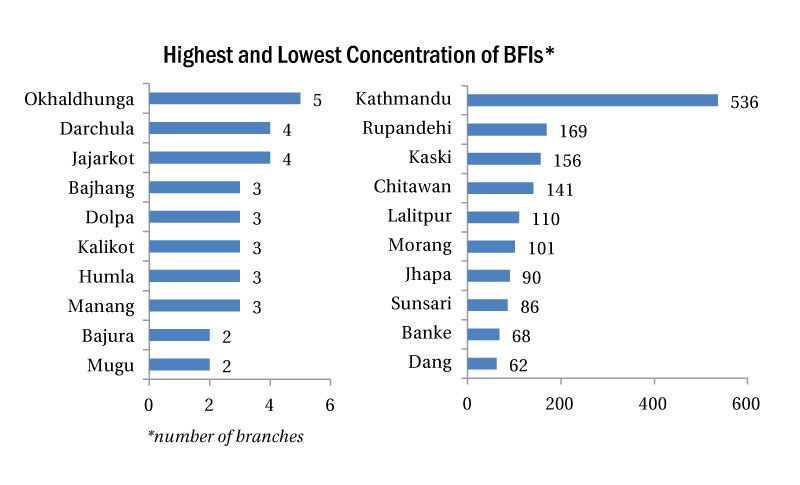
OR
Urban-centric BFIs making financial inclusion elusive
Published On: July 8, 2016 01:50 AM NPT By: Sagar Ghimire | @sagarghi

KATHMANDU, July 8: Growing concentration of branch offices of bank and financial institutions (BFIs) in urban and semi-urban areas is making the government's objective of financial inclusiveness and access to finance for all unachievable.
BFIs, which are rushing to open their offices in urban and semi-urban areas where geographical access is relatively easy, are hesitating to expand their services in rural areas, citing higher operating cost.
According to Nepal Rastra Bank (NRB), BFIs, along with microfinance development banks, have a total of 3,838 branch offices across the country as of mid-July 2015, up from 3,456 in the same period last year.
In mid-July 2015, a BFI branch, excluding the branches of 'D' class institutions, was serving approximately 10,160 people. The size of population comes down to 7,206 people per branch when branches of 'D' class institutions are also counted, according to a central bank report.
However, concentration of BFIs is still high in urban or semi-urban areas. Central development region has 1,255 branches offices of BFIs (46.1 percent), followed by western development region with 672 (24.6 percent) and eastern development region that has 437 (16 percent).
Despite the central bank's continuous efforts to increase the outreach of financial services in remote areas, the result is still not satisfactory in terms of expansion of branch offices in far-western development region. The remote, which has many remote settlements, have only
123 branch offices. Bajura and Mugu have only two bank branch offices each.

The concentration of BFIs in urban areas has continued despite the central bank's tireless efforts to encourage them to open branch offices in areas where banking services is not available. Apart from other policies that encourage BFIs to go to unbanked areas, NRB has also taken an approach of making BFIs open branch offices in rural areas in order to open additional branch office in urban areas.
At a time when the government has adopted a policy of encouraging people to open bank accounts, it is unlikely that the government will achieve desired results because of low presence of banks in rural areas. The government has said that it would provide social security allowances directly into the bank accounts of beneficiaries. However, it will be challenging as people from the rural parts may feel it impractical or difficult to come to the urban areas to open bank accounts while BFIs are reluctant to go rural areas.
The budget for Fiscal Year 2016/17 states that 'Bank Account for All Nepali' program will be launched as a campaign to encourage people to open bank accounts. “An arrangement will be made through the central bank to open zero balance bank account," the budget speech reads.
As the NRB is preparing to bring monetary policy for 2016/17 next week, it is expected that the central bank would announce programs to promote financial inclusion and 'zero balance bank account'.
Bankers say that microfinance institutions should be nudged to serve in rural areas. "The government, in its budget, has announced to open bank account for all its citizens. The central bank should do a mapping to find out where banking services are available and where not. If the central bank says that there should be a branch of microfinance in every VDCs, as commercial bank might not be logical, it is possible within two or three years," Bhuvan Dahal, CEO of Sanima Bank Ltd, said.
You May Like This

Nepal Financial Inclusion Portal launched
KATHMANDU, Oct 1: Nepal Rastra Bank (NRB) has launched Nepal Financial Inclusion Portal to track progress of financial inclusion across the... Read More...

'Lack of financial discipline in BFIs behind shortage of loan-able fund'
KATHMANDU, Feb 7: Nepal Rastra Bank (NRB) Governor Chiranjibi Nepal has said that the present mismatch between deposit collection and loan... Read More...

Financial inclusion in Nepal better: Report
KATHMANDU, July 16: The level of financial inclusion in Nepal is better with 61 percent adults having access to formal... Read More...




Just In
- Ram Nawami being observed today paying homage to Lord Ram
- Minister Shrestha vows to keep education sector free from politics, seeks EC’s help to identify teachers involved in politics
- ACC Premier Cup: Nepal vs Saudi Arabia today
- Nirmal Purja sets new record in climbing mountains higher than 8,000 meters
- Why Federalism has Become Risky for Nepalese Democracy
- Weather to remain generally fair across the country today
- Tara Manandhar appointed as CEO of Dish Media Networks
- Madhesh Council of Ministers reshuffled after LSP quits government














Leave A Comment